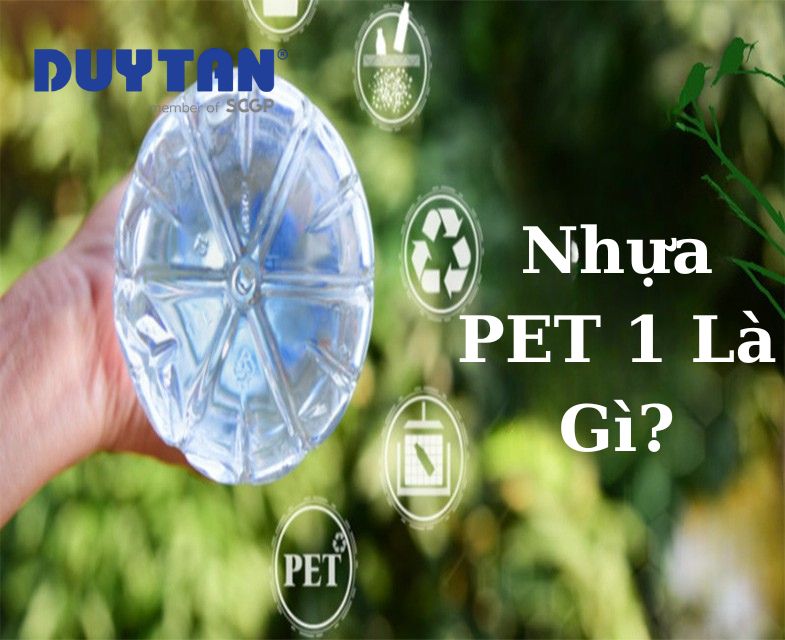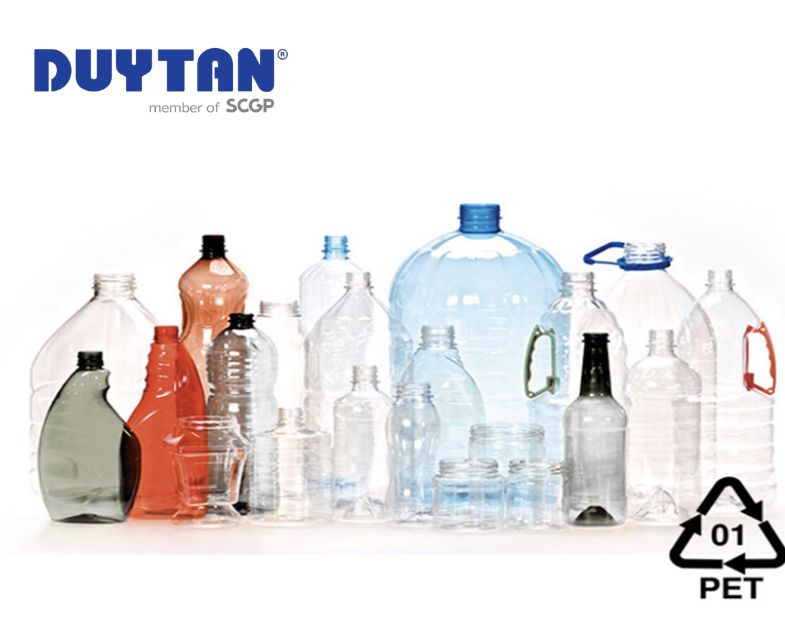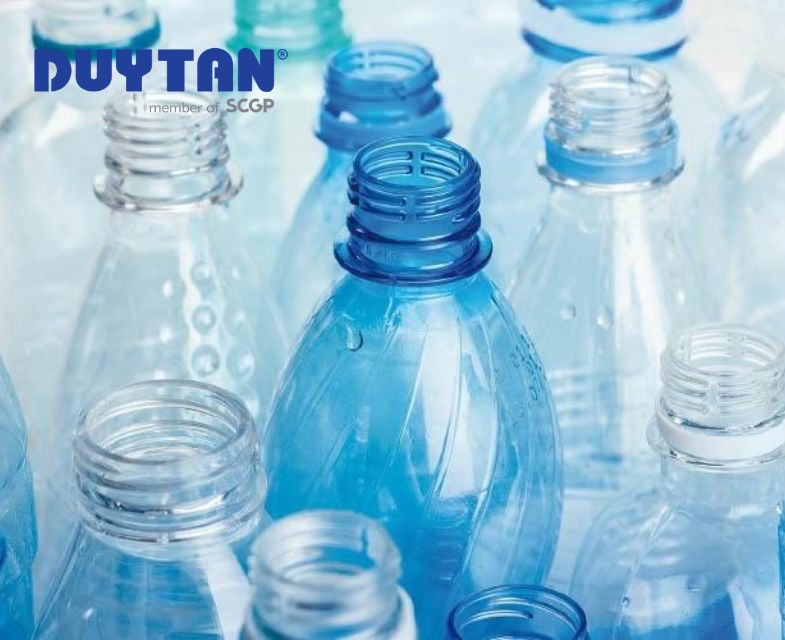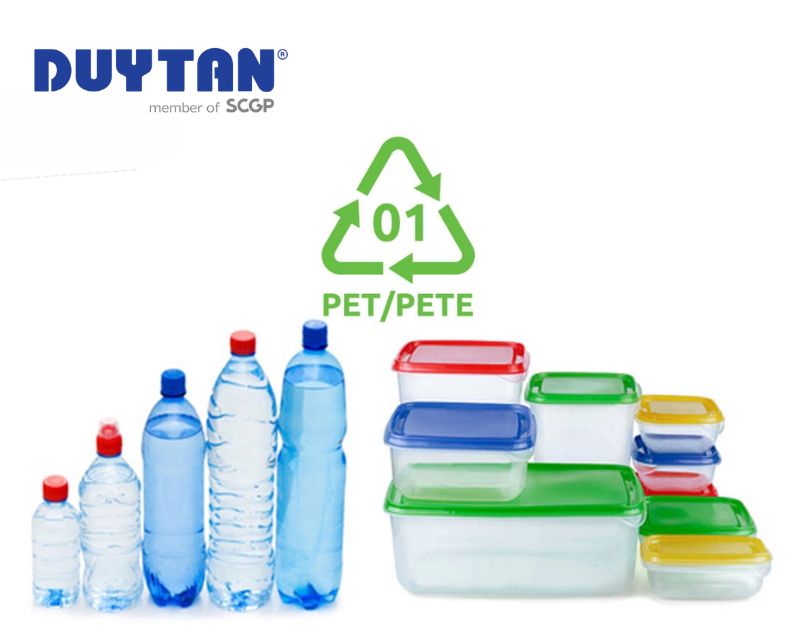PET Plastic 1
– a common plastic used in the food packaging industry – is widely found in water bottles, cooking oil bottles, and disposable plastic containers. Thanks to its lightweight, durability, and recyclability,
PET plastic number 1
is extensively used in manufacturing. However, improper usage may pose health and environmental risks. In this article,
Duy Tan
will help you understand the features, applications, and precautions when using this familiar plastic.
1. What is PET Plastic 1?
PET Plastic 1 (Polyethylene Terephthalate), also labeled as
PET or PETE
,
is the most commonly used plastic today, often found in products like
bottled water, cooking oil bottles, and disposable containers
.
This plastic belongs to the thermoplastic group, known for good moldability, light weight, transparency, and decent strength. PET 1 is usually marked with a triangle symbol containing the number
1
– the identification code for this type of plastic.

What is PET Plastic 1?
2. Why is PET Plastic Number 1 so popular?
PET plastic number 1 is currently the most widely used plastic in the packaging industry, especially for food and beverage packaging. Its popularity among businesses is no coincidence. Here are the main reasons:
-
Lightweight:
Compared to glass or metal, PET 1 is much lighter, reducing transportation costs and making storage easier.
-
Transparent and visually appealing:
PET 1 has high transparency, allowing users to easily see the product inside, enhancing the product’s aesthetic appeal.
-
Good durability:
Despite its light weight, this plastic is quite impact-resistant and durable, suitable for packaging and transporting goods.
-
Moisture resistance:
PET plastic prevents air and moisture penetration, helping preserve the product’s freshness and quality.
-
Low production cost:
PET is easy to mold and can be mass-produced at low cost, making it suitable for many industries.
Thanks to these advantages, PET 1 has become the top choice for many consumer products, from beverages to cosmetics and food. That’s why consumers often encounter this plastic in most disposable plastic products on the market.

PET 1 used in the packaging industry
3. Types of PET Plastic 1 available on the market
Today, PET plastic number 1 is divided into three main types, each with distinct characteristics and applications suitable for different market needs:
3.1 Virgin PET 1
This is new PET plastic that has not been used or recycled. Virgin PET has high purity, ensuring safety and quality for products in direct contact with food and beverages. It is commonly used in bottled water, soft drinks, and premium food packaging.
3.2 Recycled PET 1
Recycled PET is made by blending virgin PET with recycled or used PET that has been processed. It retains many beneficial properties while offering a lower cost compared to virgin PET. Recycled PET is commonly used in products that do not require high transparency or absolute safety, such as cooking oil bottles and industrial plastic containers.
3.3 Scrap PET 1
Scrap PET refers to used PET plastic recovered from bottles, jars, or other plastic items. It needs to be treated, cleaned, and recycled before reuse. Scrap PET is often used as raw material for recycled plastic products such as polyester fibers, construction materials, or plastic items not in direct contact with food.
Related products:
4. Is PET 1 plastic safe for reuse?
According to Duy Tan, PET 1 plastic was originally designed for single use, commonly found in bottled water, soft drinks, and disposable food packaging. So the question many people ask is: is PET 1 plastic safe to reuse?

Is PET 1 plastic safe for reuse?
According to experts and research, reusing PET 1 plastic bottles multiple times is not recommended for the following reasons:
-
Chemical leaching:
When PET 1 bottles are scratched, exposed to high temperatures, or used for a long time, they may release chemicals such as antimony or other additives that can negatively impact health.
-
Bacterial accumulation:
PET 1 bottles are not designed for thorough cleaning. When reused, dirt and bacteria can accumulate inside, increasing the risk of contamination or affecting the quality of drinking water or food.
-
Material degradation:
Each time it is reused, PET plastic may degrade, losing physical properties such as strength and clarity, making the bottle more prone to deformation or breakage.
5. Practical applications of PET 1 plastic
Duy Tan recognizes that PET 1 plastic is a very popular material widely used in daily life due to its outstanding features. Below are some prominent real-world applications of PET 1:
-
Beverage bottles:
This is the most common use of PET 1 plastic, including bottles for water, carbonated soft drinks, juices, and other beverages. PET plastic helps maintain clarity, cleanliness, and product quality.
-
Food packaging:
PET 1 is used for single-use food containers such as lunch boxes, fruit trays, candy containers, etc., thanks to its moisture resistance and durability.
-
Polyester fiber:
Recycled PET is used to produce polyester fiber for the textile industry, making clothes, carpets, upholstery fabrics, etc. This helps reduce plastic waste and makes efficient use of recycled materials.
-
Other applications:
PET 1 is also used in the production of items such as bottle caps, food packaging films, or small electronic components.
Thanks to features such as durability, lightness, transparency, and recyclability, PET 1 plastic has become an indispensable material in many industries, greatly contributing to a more convenient consumer lifestyle.

Practical applications of PET 1 plastic
6. Precautions when using PET 1 plastic products
When using products made from PET 1 plastic, being aware of important precautions not only protects your health but also helps maintain product quality over time. Duy Tan shares key reminders to help you use PET 1 safely and effectively.
-
Do not use for hot food:
PET 1 plastic cannot withstand high temperatures, so avoid storing hot food or beverages in PET bottles or containers to prevent the release of harmful chemicals.
-
Avoid multiple reuse:
Although it may be reused, PET 1 bottles are not designed for long-term use. Reusing them multiple times may lead to scratches, bacterial growth, and chemical leaching.
-
Avoid direct sunlight exposure:
When exposed to direct sunlight for extended periods, PET 1 plastic can deform or degrade, reducing its quality and safety.
-
Clean properly:
If you reuse PET 1 bottles, wash them with warm water and mild soap. Avoid strong detergents or abrasive scrubbing to prevent damaging the plastic surface.
-
Sort and recycle correctly:
After use, place PET bottles and containers in the recycling bin to help protect the environment and reduce plastic waste.
Thanks to its outstanding features like being lightweight, durable, transparent, and recyclable, PET 1 plastic has become an essential material in modern life. Through this article
“What is PET 1 plastic?”
Duy Tan hopes you now have a more comprehensive understanding of this plastic type and know how to use it safely and effectively.
If you're looking for high-quality, reputable, and reasonably priced PET 1 plastic products, contact Duy Tan today. We are committed to delivering top PET plastic solutions that best meet your production and business needs. Don’t hesitate—choose Duy Tan to experience premium PET 1 products and dedicated service!